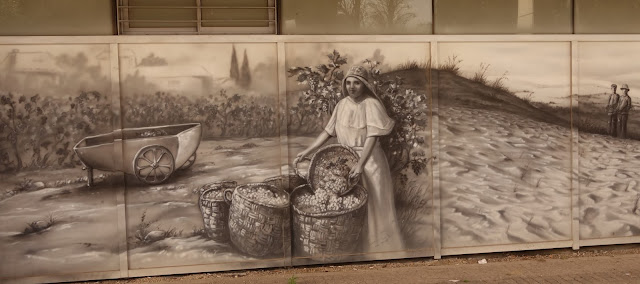Rishon LeTzion, now the 4th largest city in Israel (with about 280,000 people)
and a suburb of Tel Aviv, located just 5 miles from it, began its life in 1882 (after an early progrom in Kishinev) when it was founded as an agricultural settlement by Jews from the Ukraine in the Russian Empire. It was the 2nd Jewish farming community established in the 19th century, after Petach Tikva. The pioneers that founded the town bought 835 acres of land from local Arab villagers. They had a lot of problems with sandy soil and almost no farming experience. A well was dug
 |
| Picture of well and water tower over it in 1910. |
and the Bilu pioneers came, but the area only began to take shape when Baron Edmond de Rothschield took over, esnd in administrators and established citrus orchards, a winery and improved the farming system, conquering the sandy soil.
On April 5th, Amalia took me to Rishon. After parking the car, we headed to the historic area of town, the first streets of Rothschild and Ahad Haam. Until a few years ago, Israelis were not required to preserve historic buildings, but in the old part of Rishon, many have been preserved. They date from the pre-Bauhaus era. The residence of Rothchild's clerks has been preserved
and some of the homes of the 17 founding families. Each family got 3 dunams of land, about 3/4th acre, enough for a house, animals, and some farm land.
 |
| Shmuel Cohen's house--Cohen adapted the melody of a folk song to poem Hatikva |
 |
| The Kanner House |
 |
| Official Israel sign on Kanner House |
 |
| The Kanner house--the second story was probably an addition and has different stone work |
 |
| Notice the grill work, popular in the late 1800s |
 |
| Naftali Imber, who wrote the poem Hatikva, briefly lived in the basement in 1983 of this house |
Many of the older houses in Rishon were torn down in the 1960s as the "new" housing units were built. Other people sold their homes to move into these new units.
Some people could not afford the newer units, so they did not sell, including Amalia's parents. Now the home (and land) where Amalia's father lives is worth much much more than the units above!
 |
17 Founding families are recognized in Founders' Square
It is easy to follow the special path to go to the historic points in Rishon.
|
The water tower today is part of a special Square..
 |
| Office Building for Rothchild and his clerks, much nicer than the pioneers' homes |
 |
| Where clerks and visitors stayed. It is being refinished. |
 |
| Hotel and pension "London"--notice shutters used in the early 1900s |
The synagogue was one of the earlier buildings and was constructed on the top of the hill in the area:
Part of Rothchild's house has been turned into a museum of what the clerks did and another part is the memorial house for Rishon LeTzion, where everyone from Rishon who has died in wars or terrorist attacks in memorialized. Every town has one and this one is very powerful.
 |
| Drawing of the complex with middle glass part added recently |
Herzl visited Rishon in the early 1900s and the park was built to honor him. The tree stumps are from the original trees which were cut down (diseased?) and palms were planted behind them.
 |
| Notice "Herzl" standing on the balcony! |
OK, I diverged a bit; back to the memorial house. I had seen a special room in Kiryat Malachi, but the size and scope of this was very powerful. Several rooms were filled with list of names, organized chronologically. Under the windows, were books with photos and details about each person on the list.
 |
A close up of one column of names: The top left says "on the way to the establishment of the State of Israel.
Then those who died between 1948 and 1956. |
 |
| A page from the book: Zeleg O. born in 1941 and come to Israel in 1948. Died on July 29, 1960 |
 |
| Zeharia Guy M, son of Rivka and Meir, born in 1978 in Israel. Joined the army in 1996, on erev Pesach he died in a car accident in 1997. Also tells about his schooling, sports, things he loved. |
 |
| On the anniversary of the death of the person, details are displayed on a video. It was extremely moving. |
 |
| Newer displays with colored pictures of the fallen |
 |
| Fallen include women and recent immigrants |
 |
| Artist depiction in memory of a special group |
 |
| One room had a special, poignant display, with photos of the empty rooms of those who had died |
The custodian very kindly let us into a locked room with original furniture and papers from when the Rothschild clerks worked here.
 |
| Notice the original flooring and furniture |
 |
| Bottles and barrel from the Carmel Winery that was started and continues to function here. |
 |
| Letter from 1935 |
There is also a small section on the history of wars in Israel including this 1948 partition map that is not always easy to find.
 |
| Sinai War pictures |
We didn't stop at the town museum, but there are some things worth seeing there. Check it out at:
http://sightseeinginisrael.com/rishon-le-zion/
As we walked back to the car, we saw the new city hall. I think the old one had been in the Rothschild building.
and murals depicting the past.
 |
| And new pictures of Israeli children today! |















































No comments:
Post a Comment